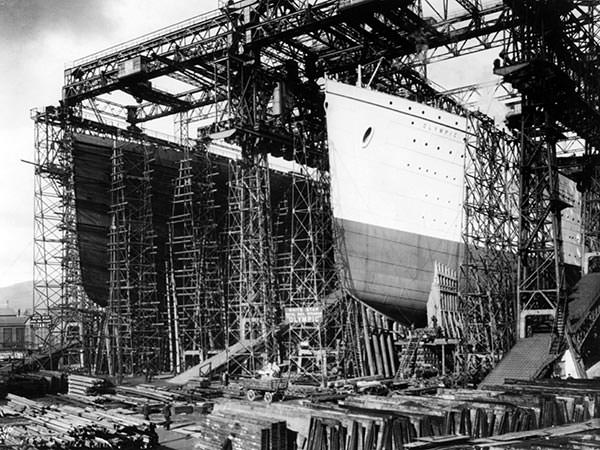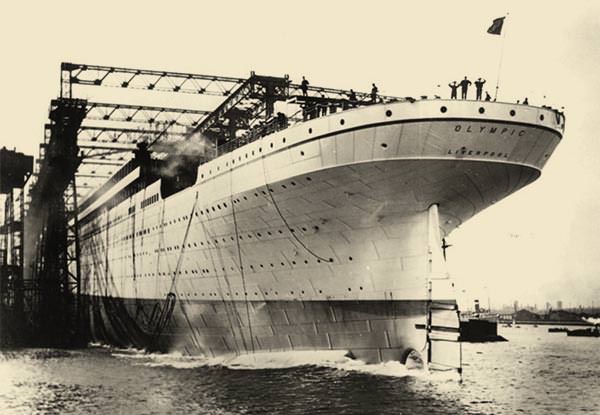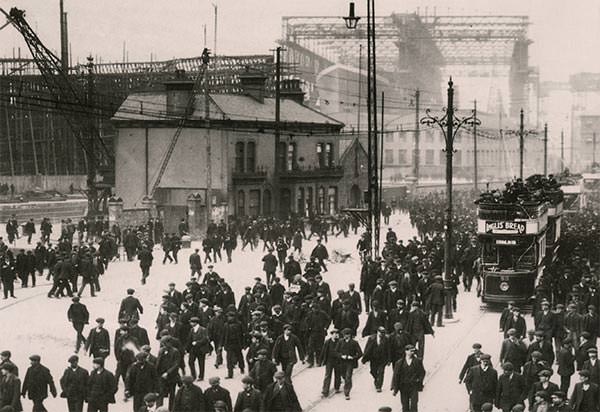The Titanic was built at the Harland and Wolff shipyard, on Queen’s Island, Belfast, Ireland.

Above: Titanic (left, on slipway 3) and Olympic (right, on slipway 2) under construction beneath the giant gantry at the Harland and Wolff shipyard, Belfast.
1858 – the year in which Edward James Harland (1831-95) bought the small shipyard that would eventually become the home of Harland & Wolff. Then employed as general manager, he struck a deal to buy the yard from his employer, Robert Hickson.
1861 – the year in which Harland, along with business partner Gustav Wilhelm Wolff (1834-1913), established the Harland & Wolff shipbuilding company.
1895 – the year in which Harland died, at which point William James Pirrie (1847-1924) became chairman of Harland & Wolff, remaining chairman until his own death, aged 77, in June 1924.
1907 – the year in which Lord Pirrie and Bruce Ismay (1862-1937), the White Star Line chairman, announced their intention to build three new Olympic-class liners, Olympic, Titanic, and Britannic.

Above: The Olympic, sister ship to Titanic, launching from slipway 2 on 20 October 1910.
1906 – the year work began on modernising the shipyard to accommodate the construction of the new super liners.
4 – the original number of slipways at the Harland & Wolff North Yard.
3 – the number of slipways created when the yard was reconstructed to handle the building of the new super liner sister ships Olympic and Titanic (one of the original four slips was retained and the remaining three replaced with two larger slipways).
£100,000 – the cost of building the giant gantry over the new slipways, which was designed by Sir William Arrol & Co, the civil engineering firm who also built the Forth Bridge in Scotland and Tower Bridge in London. At the time it was the largest gantry in the world, and dominated the Belfast skyline.
228 feet – the height of the gantry (69 metres).
840 feet – the depth of the new gantry from front to back (256 metres).
270 feet – the depth of the new gantry from front to back (82 metres).
6,000 tons – the approximate weight of the gantry.
29 July 1908 – the date on which Bruce Ismay and Harold Sanderson, for White Star Line, met with Lord Pirrie and other representatives for the shipbuilders, at the Harland & Wolff offices in Belfast. The meeting was to discuss general plans for the new ships, and with the order confirmed two days later, Harland & Wolff had the go-ahead to commence construction.
401 – the yard number given to Titanic when her keel was laid down (Olympic was yard no. 400).

Above: Workers heading home from the Harland and Wolff shipyard. In the background, beneath the Arrol Gantry, Titanic sits under construction.
16 December 1908 – the date on which the keel of the Olympic was laid down.
2 – the number of the slipway on which Olympic was constructed.
31 March 1909 – the date on which the keel of Titanic was laid down.
3 – the number of the slipway on which Titanic was built.
Did You Know?
The Titanic was built on a ‘cost plus’ basis. This simply meant that all of the costs of building the ship (labour and materials) were passed on to the owners, White Star Line, with the shipyard’s profit margin added to the bill.
More To Explore
Now you know more about the shipyard where the ship was built why not discover the company who built the Titanic, read all about this magnificent but doomed ship, or find out how the ship sank on her journey to New York.
